The French Far-Right On Telegram: Laundering Extremism Through Support For Political Activism
| by CTEC Staff
The popular success of the far-right political party National Rally in France has allowed for fringe views on immigration, race, and democracy to achieve some mainstream acceptance. National Rally poses an additional concern, however: it has deep ties to the French extreme right, including white supremacist movements like Génération Identitaire. Many of these groups appear to treat National Rally as a political Trojan horse of sorts to spread more violent, hardline, and ethnoseparatist views. In this paper, we explore the methods by which a specific far-right collective with a public Telegram channel use support and activism for National Rally to covertly spread beliefs in line with neo-fascist accelerationism.
Research and writing on this paper was led by one of CTEC’s summer interns. For safety reasons, we are publishing this piece anonymously. If you are a journalist, researcher, or other professional who would like to speak to the author, contact Alex Newhouse (anewhouse@middlebury.edu).
The political climate in France has undergone a shift to the right in recent years with the rise and rehabilitation of the Rassemblement National (National Rally), formerly known as the Front National (National Front). Led by Marine Le Pen, the RN has become increasingly influential across France. The RN has grown into a focal point of far-right ideology in mainstream French politics, even while it has toed the line between the extreme and the mainstream. The party has doubled down on this balancing act under Le Pen’s leadership, as the party has shifted its public image in an attempt to embrace the disgruntled and left-behind French working class.
Despite this image, a 2018 Aljazeera investigation exposed deep connections between the RN and the far-right identitarian group Génération Identitaire (Generation Identity). GI is a group that subscribes to an identitarian philosophy as well as the Great Replacement Theory. These two beliefs intertwine and manifest within GI as distrust of immigrants and all immigration. French author Renaud Camus first postulated the Great Replacement conspiracy theory, which alleges that, through immigration from Africa and the Middle East, French people are being replaced by minority groups. The Great Replacement is also inherently anti-Semitic, generally blaming immigration on the machinations of supposed Jewish elites. This is also closely linked to allegations of job-stealing by immigrants and other anti-immigrant rhetoric, which often try to connect minorities to intrinsic threats of violence and terrorism. In France, this particularly relates to anti-Muslim rhetoric. GI does not publicly advocate for violence, but its members often seeks out minorities in the streets to stir up altercations. Likewise, GI has taken actions to suppress immigration to France under the guise of aiding border police. GI is still considered a fringe group and was recently banned by the French government in early 2021; however, the links between their membership and the RN’s membership highlight a generalized acceptance of these more extreme far-right beliefs within the membership of the primary far-right political party in France.
The RN and GI are two of the most public and visible faces of the far-right in France, but smaller, more extreme movements exist that operate primarily on chat apps like Telegram. These groups tend to promote more radical beliefs than the RN or even GI, at least outwardly. This paper will focus on one such group identified by CTEC: a French neo-fascist Telegram group that is part of a larger collective and has a Telegram membership of 501 as of July 26, 2021.
For the purposes of this paper, the name of the neo-fascist Telegram group has been redacted and removed. The group has ties to larger neo-fascist accelerationist organizations and, as such, will not be named and will instead be referred to as the “French neo-fascist Telegram group.”
The feed is kept updated by one single account, which authors the majority of the posts published to the group aside from a few reposted messages from similarly right-wing groups or figures. Most posts reference local issues around the city of Arras in Northern France; the author of the posts likely lives there or has some connection to the city.
The French neo-fascist Telegram group is an example of a relatively small scale far-right extremist group that traffics in xenophobic rhetoric and violent, anti-immigrant ideas. One might expect a group with a neo-Nazi-inspired profile photo to be more explicit with their language; instead, the post’s author uses highly coded language to express their ideas. They often employ misleading comparisons, “law and order”-style rhetoric, and other masking tactics to disguise more extreme beliefs beneath neutral-sounding phrasing. This coded language is the focus of this paper; a linguistic analysis of the posts in the group’s public Telegram feed will highlight the extreme ideals hidden below the surface-level rhetoric. Beyond a linguistic analysis, this paper will also consider the way extreme groups like this act in support of more mainstream but still far-right political groups, like the RN. Despite the use of highly coded language to disguise the extreme neo-fascist beliefs of this group, their other social media accounts more explicitly endorse the Great Replacement conspiracy theory and accelerationism. As such, the group is much more extreme than their Telegram postings would lead one to believe.
Analysis
The profile photo for the French neo-fascist Telegram group is a combination of various neo-fascist references and imagery. When placed together in this context, it becomes easy to identify this group as neo-fascist and likely accelerationist, even without the explicit evidence from its other social media accounts. As this is the first impact the group has on a reader, it is essential to understand the implications of the image to comprehend the coded nature of the language the primary author uses when writing posts. Figure 1 below is a redacted screenshot of the profile image that showcases the various neo-fascist symbols that identify the group as aligned with the neo-fascist milieu.

The image depicts a figure dressed in a knight’s armor holding a shield adorned with Nordic runes and a sword. Behind the figure is a sun symbol. Both the runes and the sun symbol are neo-fascist red flags, and they have often been adopted by violent neo-Nazi and neo-fascist groups. The runes on the shield are a combination of the tiwaz, eihwaz, and ansuz runes, and the sun symbol is a variation on the esoteric fascist-affiliated vril symbol and the occult Nazi sonnenrad symbol. The tiwaz rune has been used since the Third Reich in various symbols and uniforms, notably in different variations of Nazi SS uniforms. Users of the Iron March forum and other neo-fascist accelerationist groups have also adopted it in recent years. Both the eihwaz and ansuz runes adorned SS uniforms at different times during the Third Reich. Likewise, the variation on the sonnenrad in the background evokes nazism and fascism as it has become synonymous with contemporary neo-fascist groups. Just as the Nazis used Nordic and Celtic runes and symbols of their regime and ideology, neo-fascist groups have adopted the same practice. The symbolic nature of these symbols makes them cryptic to those who do not have a background in far-right research or specialized knowledge of these runes, which allows for groups who use them to hide from public attention even while signaling to one another.
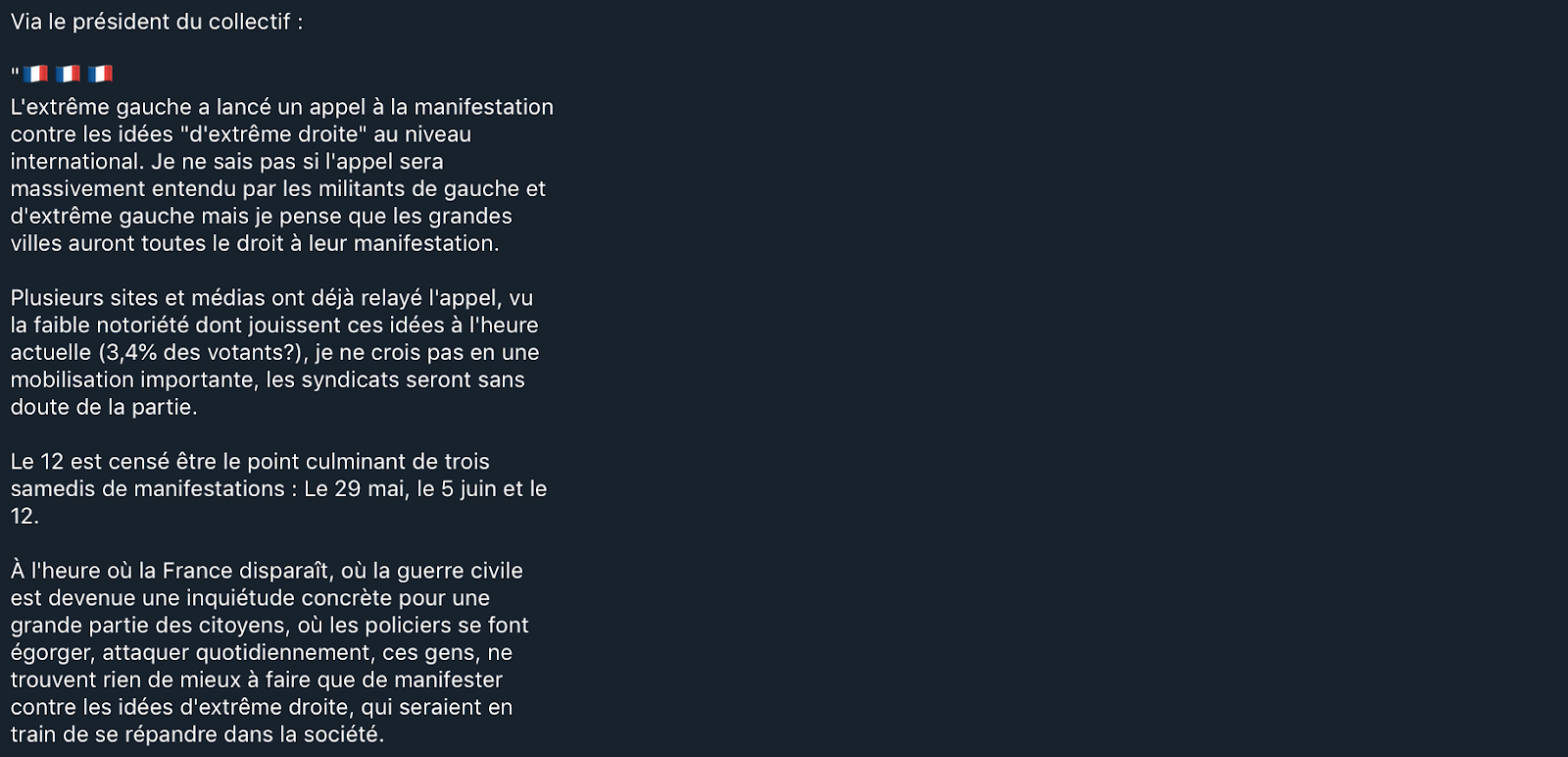
Via the president of the collective:
(3x French Flag emoji)
The extreme left has launched an event against the ideas of the “extreme right” on the international level. I do not know if the call will be overwhelmingly heard by militants of the left and of the extreme left, but I think that the large cities will have the right to their demonstration.
Several sites and media have already relayed the call, given the low profile of these ideas at the moment (3.4% of voters), I do not believe this is an important mobilization, the (trade) unions will undoubtedly be there.
The 12th is supposed to be the culmination of three Saturdays of demonstrations, 29 May, 5 June, and 12 June.
At a time when France is disappearing, where a civil war has become a concrete concern for a large portion of citizens, where police have their throats sliced, attacked everyday, these people can find nothing better to do than protest against the ideas of the extreme right, which are said to be spreading in society.
Figure 2 was published to the French neo-fascist Telegram group on May 28, 2021. It references a march against racism and hate in France that was to take place in major urban centers across the country for three Saturdays. The author makes several interesting choices in the wording of this post which alleges a broader left-wing conspiracy while simultaneously downplaying the power the left has in France. The suggestion that the media has “relayed the call” seems to insinuate that media coverage of this protest is in some way a rallying cry for left-wing activists in France. This is rhetorically similar to American right-wing activists suggesting that media outlets are working with the left. In using this rhetoric, the post’s author subtly hints that French media is actively working against right-wing causes. In the same sentence, though, the author calls the ideas behind the protest “low-profile,” citing a 3.4% of voters’ statistics. This is likely misleading given that the protest they are referencing is a broader one and is likely not tied to a single political party or candidate.
The author also notes that the unions will be at the march; in France, this is a reference to a still-powerful left-leaning sect of the French population. While the author disguises the early portion of the post to a certain extent, the final few sentences of the post are more explicit. Tying the group’s rhetoric to a growing anticipation of civil conflict within Western nations, the author writes, “At a time when France is disappearing, where a civil war has become a concrete concern for a large portion of citizens…” By suggesting the possibility of a civil war contextualized in the broader format of a neo-Nazi-influenced Telegram channel, the possible connection to the Grand Replacement (Great Replacement) theory and accelerationism are difficult to ignore. French right-wing activists are often concerned about significant migration from the Middle East and North Africa. This anxiety is often inherently linked with concerns about the general degradation or replacement of French culture and society. In other posts, the group is more explicit about these concerns, but the echoes of this xenophobia are still present in this post. The reference to police getting their throats sliced is specific to a recent incident where a police officer was killed. In extrapolating specific incidents like the murder of one officer by an immigrant into plurals, the author creates a sense that violent action against law enforcement perpetrated by immigrants and the left is much more common than it is in reality. These rhetorical strategies are common throughout many of the French neo-fascist Telegram group’s postings and are a form of the coded language they often employ.
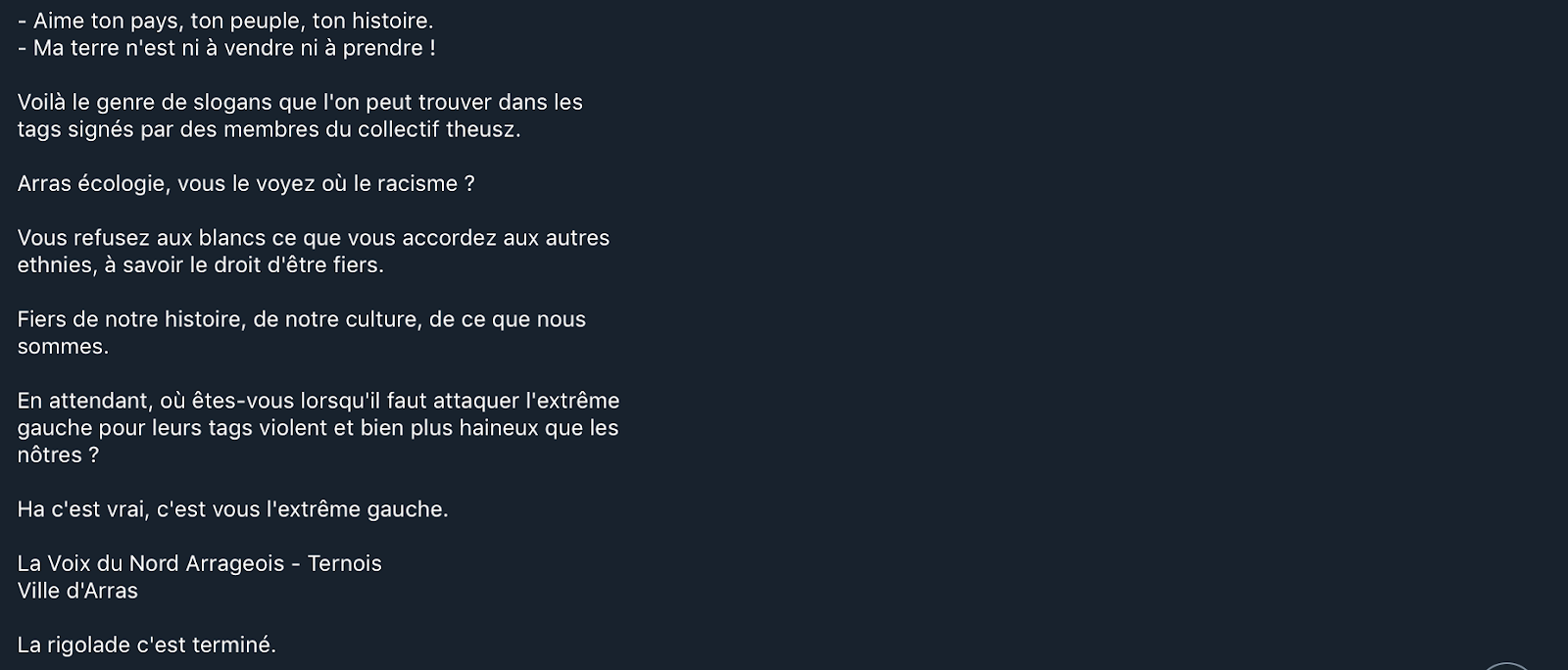
Love your country, your history, your people.
My land is neither for sale nor for taking!
These are the kinds of slogans that can be found on the tags signed by members of [redacted] collective.
Arras Ecology, you see it where is the racism?
You deny whites what you grant other ethnicities, namely the right to be proud.
Proud of our history, our culture, and who we are.
In the meantime, where were you when it comes to attacking the far left for their violent tags and much more heinous than ours?
Ha that’s right, you’re the far left.
La voix du nord Arrageois - Ternois City of Arras.
The fun is over.
Figure 3 was posted on the group’s feed on March 13, 2021. It primarily discusses an incident in the city of Arras in northern France where the city removed far-right graffiti. It appears that these specific “tags” were placed there by members of the French neo-fascist Telegram group in Arras, which would make their removal more personal for the post’s author. The post quotes two specific slogans from these tags: “Love your country, your history, your people,” and “My land is neither for sale nor for taking.” Contextualized both within the larger far-right themes of the posts as well as within the language used later in this post, these two slogans allude to much deeper and more extreme ethnoseparatist beliefs.
The first slogan that the author quotes is masked as a simple statement of French pride. However, as one continues to read, the author addresses Arras Ecology, the Arras branch of a left-leaning French political party, essentially asking why other ethnicities can be proud of their culture but whites are denied the same right. This thread can be tracked through other posts in the group and white supremacist and xenophobic groups worldwide.
The second slogan they reference is similarly coded; however, in this instance, it is likely referring to the “theft” of French land by immigrants. By claiming personal ownership of the land, the post’s author suggests that land in France should be under French ownership. Rhetorically, the phrasing suggests some malicious force or group is trying to steal French land, and this imagined group is likely non-white immigrants to France.
These slogans seem harmless and straightforward on the surface, but on a deeper level, the author codes the language to evoke a more malicious meaning. In obscuring the underlying meaning of these slogans, far-right groups can claim the suppression of free speech and anti-right bias because nothing is explicit. Strategically, this can help solidify support on the right. The author also draws a contrast between their slogans and left-leaning graffiti, and not directly quoting the “heinous” extreme left graffiti allows the author to claim neutrality in their messaging. This framing develops a sense of incongruity in the treatment of right-wing versus left-wing messaging. In other posts, the author explicitly references this incongruity as “Two weights, two measures.” Essentially, the channel claims that the government and public is quicker to condemn the extreme right’s rhetoric and messaging than that of the extreme left.
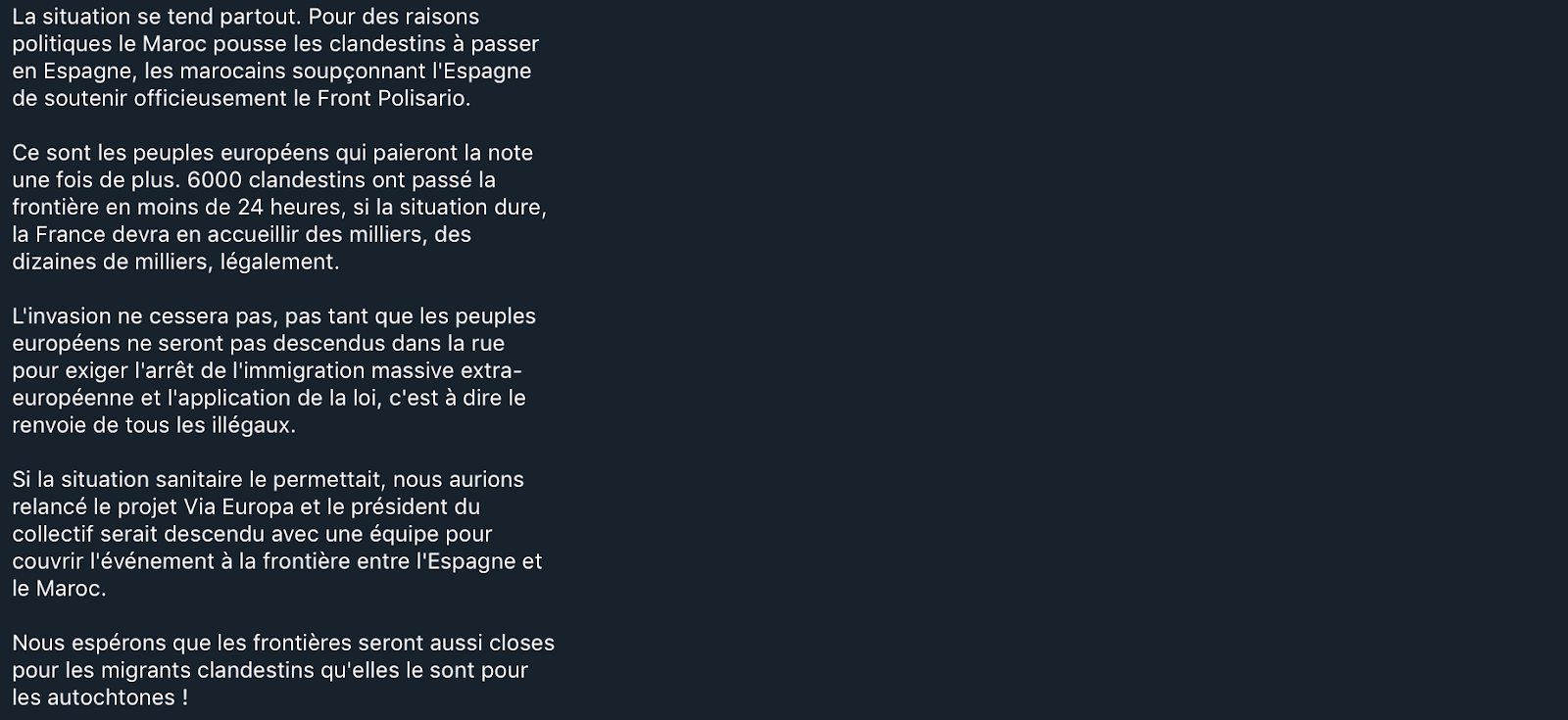
The situation is straining everywhere. For political reasons Morocco pushes the illegals to cross into Spain, the Morrocans suspect Spain of supporting the Polisario Front. (look this up).
It is the peoples of Europe who will foot the bill once again. Six thousand illegals crossed the border in less than 24 hours, if the situation continues, France will have to welcome thousands, tens of thousands, legally.
The invasion will not stop, not until the peoples of Europe have descended into the streets to demand an end to the massive extra-European immigration and the application of the law, that is to say the dismissal of all illegals.
If the health situation permitted, we would have relaunched the Via Europa project and the president of the collective would have come down with a team to cover the events on the border between Morocco and Spain.
We hope the borders will be as closed for migrants as they are for locals.
The post in Figure 4 appeared on May 18, 2021. It deals primarily with the issue of migration from North Africa to France via Spain. The idea of two weights, two measures is again prevalent as the author focuses on a perceived incongruity in the enforcement of health regulations regarding COVID-19. The author concludes the post by stating, “We hope the borders will be as closed for migrants as they are for locals,” essentially arguing that the government should treat flows of migration and health crisis-related travel restrictions in the same way. Again, the author constructs their rhetorical strategy to associate migrants directly with the virus and, in a broader sense, with a threat to France. Of course, this is couched in comparison to national travel restrictions; thus, the author can establish these implicit links between migration and disease without using explicitly xenophobic language.
Earlier in the post, however, the author’s anti-migration bias is more clearly outlined. They focus on the issue of legal migration to France, writing that tens of thousands of migrants have been legally welcomed to France. Often undocumented migration will take center stage in xenophobic discussions of migration, likely as a strategy to mask anti-migrant biases, but this post pushes explicitly against legal migration. They construct a view of migration that portrays foreigners as a burden to France, saying, “It is the peoples of Europe who will foot the bill once again.” In this way, the author is simultaneously pushing against migrants and the French government. They call for the peoples of Europe to descend into the streets and protest against the “massive extra-European immigration” they see plaguing the continent. It is worth noting that this language is not explicitly anti-intra-European immigration. This leaves the reader with the sense that perhaps the author is not inherently opposed to Europeans migrating between European countries; in this way, the author’s bias towards immigrants of color comes more sharply into focus. In addition, using the term “peoples of Europe” instead of “Europeans” casts their opposition to immigration in explicitly ethnic terms.
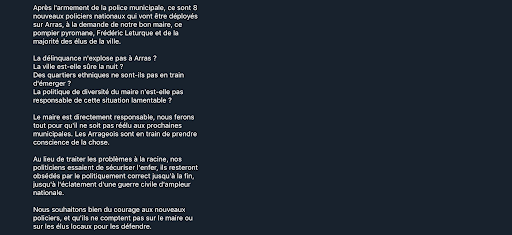
After the arming of the municipal police, eight new national police will be deployed to Arras, at the request of our good mayor, the pyromaniac firefighter, Frédéric Leturque, and the majority of the city’s elected officials.
Does delinquency not explode in Arras? Is the city safe at night? Are ethnic neighborhoods not emerging? Is it not the mayor’s diversity politics that are responsible for such a lamentable situation?
The mayor is directly responsible, we will do everything to make sure he is not reelected in the next municipal election. The people of Arras are realizing this.
Instead of dealing with the problems at the root, our politicians try to secure hell, they will fixate on political correctness until a national civil war breaks out.
We wish courage to all the new police officers, and that they do not count on the mayor or local elected officials to defend them.
Figure 5 was published on May 22, 2021. It deals with the armament of municipal police in Arras and the deployment of eight new national police officers to the city. However, this context serves more as a segue into a discussion of safety with regard to neighborhoods populated by migrants. The author directly ties questions of the city’s safety after dark with the presence and increase in “ethnic” neighborhoods. The post pushes to place blame for this alleged danger on undefined diversity programs implemented by the city’s mayor.
This Telegram group specifically is centered in the city of Arras. As such, the author centers their political commentary around a critique of Frédéric Leturque, Arra’s mayor, for adopting progressive policies. Although the post is couched in support of police forces, this is often a right-wing calling card that lends itself to developing a “law and order” centered rhetoric. The author suggests that “ethnic” neighborhoods contribute to crime and decrease safety in Arras, and progressive support for decreased police presence furthers this lack of safety. In expressing support for the police, it would seem that the post’s author aims to use xenophobic safety concerns to advocate for increased police presence while simultaneously framing the local government as anti-police, and therefore anti-law and order. This rhetorical framing is standard in far-right discourse, and this post fits in with the general themes of the French neo-fascist Telegram group’s broader posting behavior.
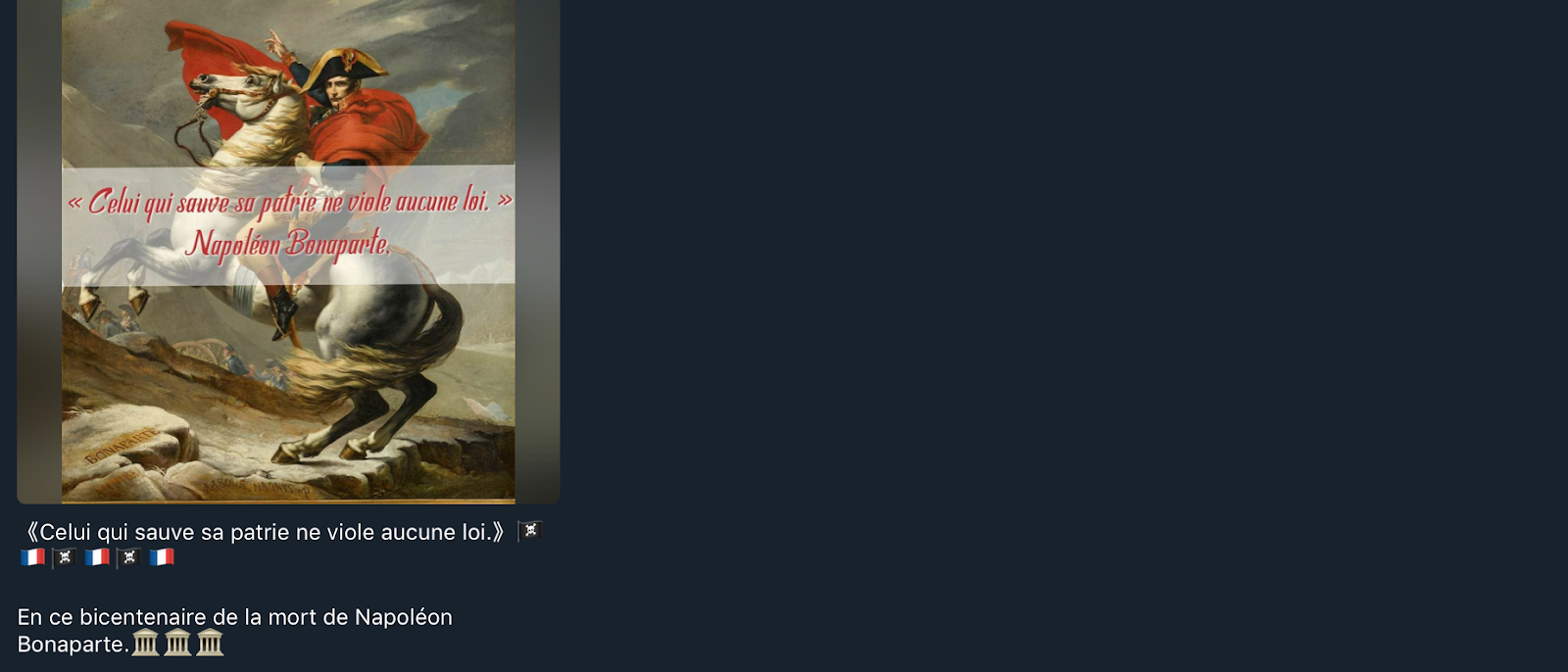
‘Whoever saves his homeland does not violate any law.’ [Alternating French and pirate flag emojis]
It is the bicentennial of Napoleon Bonaparte’s death.
Figure 6 was posted to the French neo-fascist Telegram group’s feed on May 5, 2021. The post, though short, captures the kind of historical connections the author often relies on as justification for their xenophobic postings. The quote they use reads: “Whoever saves his homeland does not violate any law.” This quote is not explicit in its meaning or context but is able to fit the author’s rhetoric of defending French culture. This post is not particularly violent without context. However, within the general messaging of the Telegram group, it becomes coded as a historical justification for defending France from an imagined outside threat. Napoleon Bonaparte, the French leader who conquered Europe in the early 19th century, becomes deified as a defender of France and French culture. This post illustrates the use of history and significant historical figures to justify xenophobia as they become linkages to the past. By attempting to graft Napoleon’s words to the current political climate, the author can link their identity and politics to history.
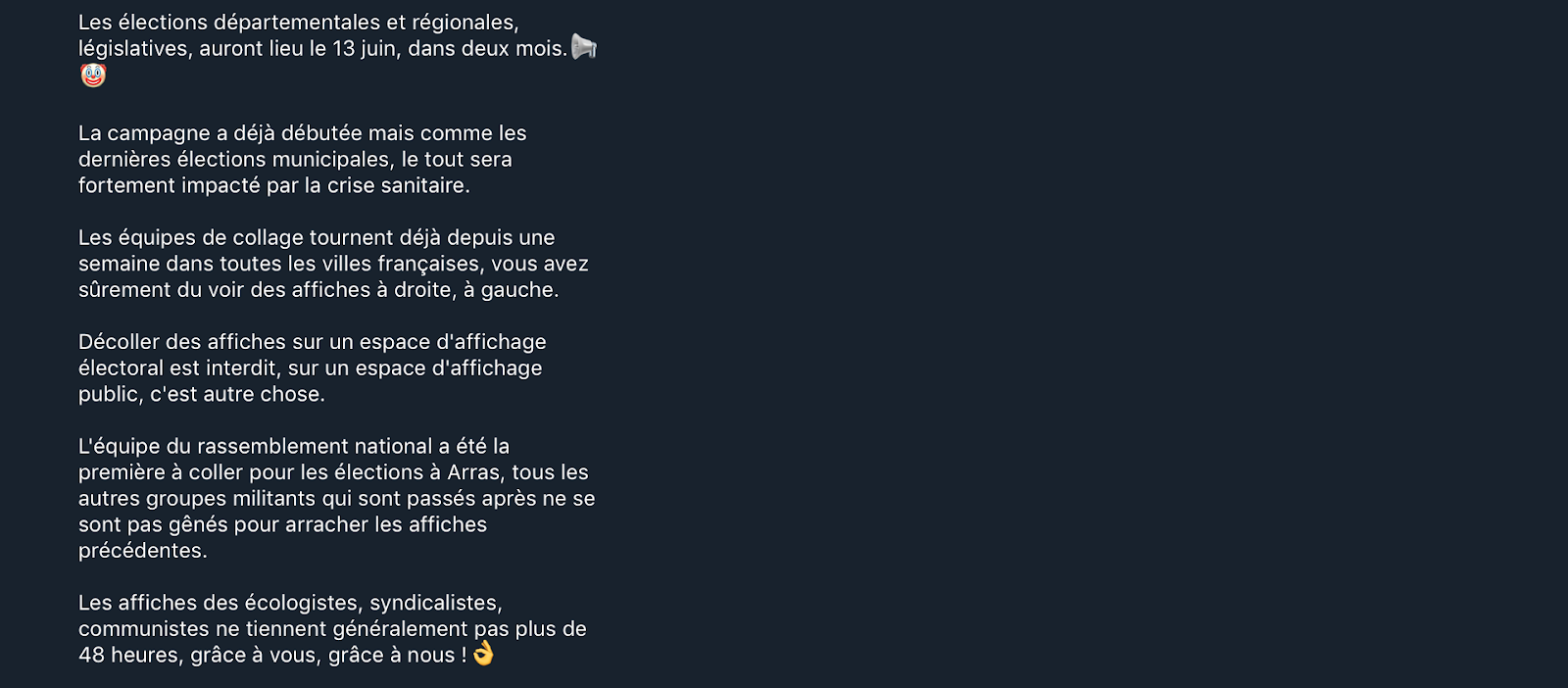
The departmental and regional elections, legislative, will take place on June 13, in two months.
The campaign has already started, but like the last municipal elections, everything will be greatly impacted by the health crisis.
The college teams have already been running for a week in all French cities, you must have seen posters, on the right and on the left.
Removing posters from an electoral display is prohibited, but from a public display, is a different thing.
The National Rally team was the first to paste (put up posters) for the election in Arras, all other militant groups that passed after did not hesitate to tear down the preceding posters.
The posters from the environmentalists, trade unions, and communists generally do not last for more than 48 hours, thanks to you, thanks to us!
Figure 7 was published to the group’s feed on April 1, 2021. It primarily discusses strategies for pushing far-right candidates in the June 13 regional elections. The author spends a significant amount of time discussing strategies for postering for the National Rally and removing the posters for competing political parties and groups, like the environmentalists, trade unions, and communists. The author discusses specifically how anyone can remove posters from walls and public areas that are not electoral displays and suggests that through personal and group action, the posters put up by rival political groups do not last for more than 48 hours.
This language is interesting because it is inherently akin to political strategies used by mainstream political entities. In the context of this Telegram group’s extreme rhetoric and ideology, their discussion of mainstream political action feels incongruous. However, in engaging in discourse about mainstream political strategies like postering, the author highlights an underlying symptom of the rise of far-right beacons like Marine Le Pen and the RN in mainstream French politics. Despite being less extreme than the rhetoric of this particular group, the RN is still able to garner support from more extreme factions. Fundamental disagreements and condemnations of violent rhetoric on the part of the RN becomes less important to members of groups like the French neo-fascist Telegram group because, should the far-right gain power in the upcoming election, right-wing action would regardless become easier to engage in. If a neo-fascist group like this can stomach actively supporting a political party that publicly condemns neo-fascist ideals, it highlights how the extreme right is willing to unify under Marine Le Pen and the RN.
Conclusion
The French neo-fascist Telegram group that is the subject of this paper is a small-scale right-wing extremist group that engages in mainstream political action and uses highly coded language. However, despite its size, the group is a strong case study for exploring the implications of far-right extremism and neo-fascism contextualized within the current French political landscape. This paper draws two main conclusions from a linguistic analysis of the posts in the French neo-fascist Telegram group.
The first relates to strategies for communicating extreme ideas in layered ways so as to mask their extreme nature beneath a benign exterior. For example, the author of the posts in this group uses highly coded language to suggest connections between neighborhoods primarily populated by immigrants and increased violence or to link migration flows with the spread of COVID-19. In doing so, they can contextualize their xenophobic views beneath statements with implicit biases rather than explicitly hateful comments. Coded language allows groups like this one to espouse their ideas more publicly. For example, rather than explicitly saying that non-white immigrants should not be allowed to immigrate to France because of their skin color, they instead suggest an inherent connection with non-white immigrants and larger social issues like violence, the pandemic, or economic turmoil. This strategy is evident in almost all of the posts in the Telegram group. It aids the author when they attempt to argue against immigration and the removal of right-wing graffiti in particular.
The second major conclusion is that despite the extreme nature of the posts in this group and the imagery in its profile image, there still exists support for more mainstream political figures like Marine Le Pen and even clear examples of mainstream political action and participation in the electoral process. The RN is certainly right-wing and, to a certain extent, extreme, but the views expressed in the French neo-fascist Telegram group, as well as the symbols in its profile image, would almost certainly be condemned by the RN at least outwardly. Despite this, there are many pro-RN posts in the group and even examples of group members posturing for the RN and actively supporting their campaigns. This is likely the result of an understanding that if the RN gains significant political power, more extreme right-wing goals would be easier to advance. Thus, in participating and supporting the RN, members of this group can see victories for Marine Le Pen and RN politicians as victories for their more radical ideas as well.
These two common aspects of the generalized posts on the French neo-fascist Telegram group highlight the strategic use of language and political action to normalize the extreme ideals the group adheres to and simultaneously engage with French politics in a mainstream way. Rhetorically this shifts the group closer to mainstream discourse as they conceal violent and xenophobic ideals beneath coded language. These strategies mirror those of other far-right extremist groups and help aid in understanding how far-right extremism is growing in France and in Europe as a whole.
References
- Azani, Eitan, Liram Koblenz-Stenzler, Lorena Atiyas-Lvovsky, Dan Ganor, Arie Ben-Am, and Delilah Meshulam. “The Far Right — Ideology, Modus Operandi and Development Trends. Report” International Institute for Counter-Terrorism (ICT), 2020. 13-36. Accessed August 2, 2021. http://www.jstor.org/stable/resrep30906.6.
- Aljazeera Investigative Unit, “Generation Identity: France shuts down far-right group,” Aljazeera, March 3, 2021. https://www.aljazeera.com/news/2021/3/3/generation-identity-france-shuts-down-far-right-group
- Generation Hate Part 1, directed and edited by Aljazeera’s Investigative Unit (December 2018, online.) https://www.aljazeera.com/news/2018/12/26/generation-hate-part-1
- Generation Hate Part 2, directed and edited by Aljazeera’s Investigative Unit (December 2018, online.) https://www.aljazeera.com/news/2018/12/26/generation-hate-part-2
- “Hate On Display Hate Symbols Database,” Anti-Defamation League. https://www.adl.org/hate-symbols?keys=norse
- Onishi, Norimitsu. “The Man Behind a Toxic Slogan Promoting White Supremacy.” The New York Times, September 20, 2019. https://www.nytimes.com/2019/09/20/world/europe/renaud-camus-great-replacement.html
